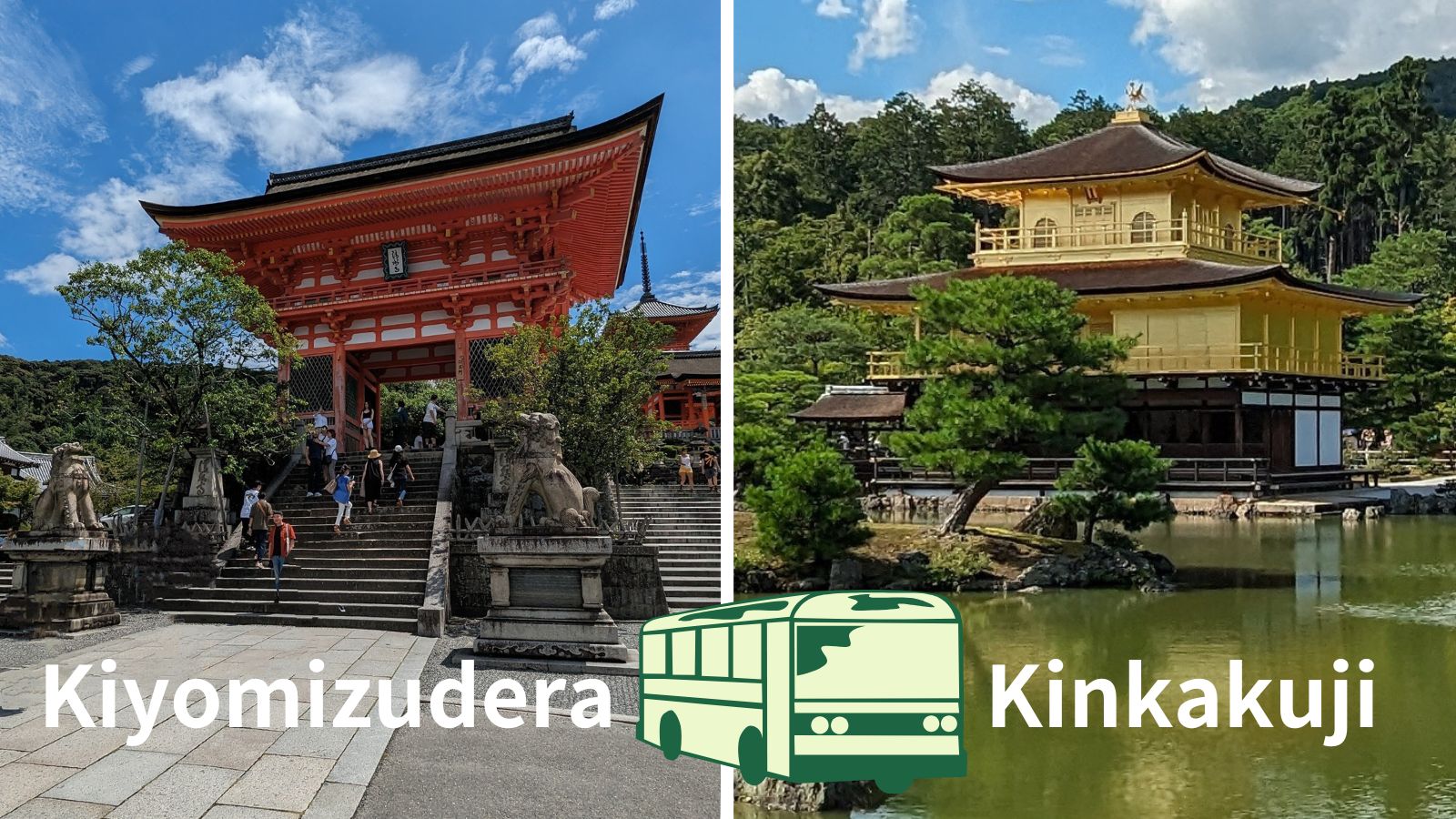

In our Kyoto sightseeing on August 16, 2023, we visited "Kiyomizu-dera" and "Kinkaku-ji".
We used public transportation (Kyoto City Bus) to travel from Kiyomizu-dera to Kinkaku-ji, choosing a route that included a transfer at the underground Kitaoji Bus Terminal to avoid the summer heat as much as possible. Here,
we introduce the Kyoto City Bus route we took, the "Sennichi Mairi" at Kiyomizu-dera, our visit to Kinkaku-ji, and Kyoto Gozan Okuribi (Daimonji Bonfire).
From the Nio-mon Gate of Kiyomizu-dera, go down Kiyomizu-zaka to Higashioji (Higashiyama) Street. Cross the signal at the Kiyomizu-michi intersection and turn right to find the Kiyomizu-michi bus stop for northbound buses.

Go down the crowded Kiyomizu-zaka to the 'Kiyomizu-michi' (northbound) bus stop.

From the Kiyomizu-michi bus stop, take route 206 to Kitaoji Bus Terminal; route 206 runs approximately seven times an hour.
You cannot go directly from Kiyomizu-dera to Kinkaku-ji by a single bus. There are several transfer options, but transferring at a regular bus stop can be tough in the summer heat. Therefore, we chose a route that transfers at the underground Kitaoji Bus Terminal. The travel time is almost the same for any route.

About 35 minutes from Kiyomizu-michi, we arrived at Kitaoji Bus Terminal, a hub in northern Kyoto directly connected to Kitaoji Subway Station. Here, the bus stops are color-coded: red for eastbound buses, blue for westbound buses, and green for the subway, making it easy to transfer even for first-timers.

Kinkaku-ji is on the west side of the city, so go to the blue bus stop. Take the 204 bus from G stop or the 205 bus from E stop to the nearest bus stop, Kinkakuji-michi. The bus stops are separated from the street by glass doors that open when the bus arrives.
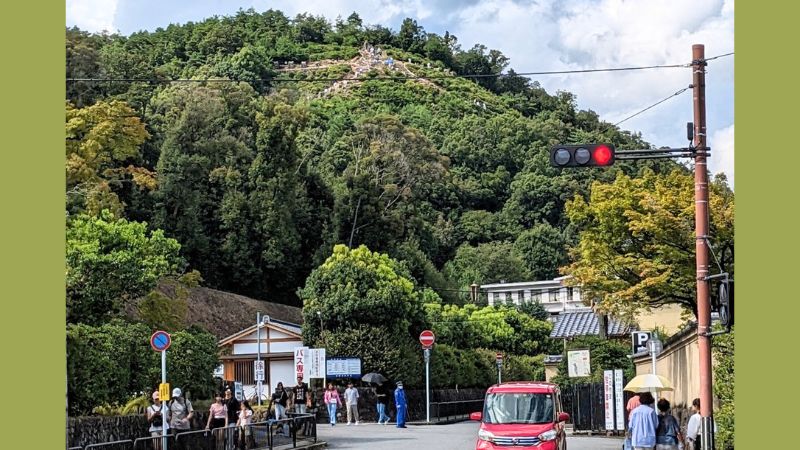
It took about 15 minutes from Kitaoji Bus Terminal to Kinkakuji-michi, and about 60 minutes in total from Kiyomizu-michi, including the transfer time. It is about a 5-minute walk from Kinkakuji-michi bus stop to the entrance of Kinkaku-ji. As you walk towards Kinkaku-ji, you will see Hidari-Daimonji Bonfire in front of you.
From August 9 to 16, Kiyomizu-dera holds the "Sennichi Mairi" event. It is said that one visit during this period is equivalent to 1,000 days of worship. The inner sanctuary, which is normally closed to the public, can also be viewed (reception open 9am to 5pm), and from 14-16 August night-time viewing is available (reception open 6.30pm to 9pm).

Kiyomizu-dera in midsummer. The bright red Nio-mon Gate stands out against the clear blue sky. In the background, you can see the West Gate and the Three-storied Pagoda.
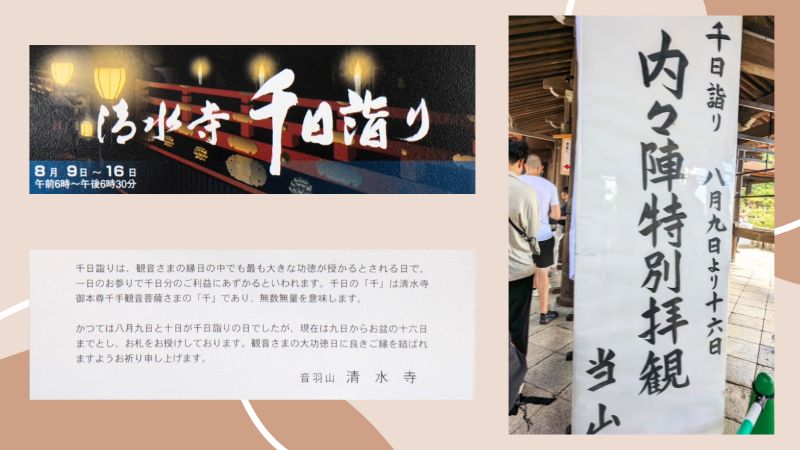
The admission ticket has a different design than usual. The fee is the same, 400 yen. We lined up for the special admission to the inner sanctuary just before the main hall entrance (reception from 9am to 5pm).

After about 25 minutes of waiting, we reached the entrance. Photography is prohibited inside the inner sanctuary. The visit takes about 10 minutes, and we received a talisman at the exit.

Due to the typhoon the previous day, the Nambu wind chimes, a summer feature, were removed from the entrance of the main hall. Near the entrance, you can see Benkei's iron geta and shakujo (staff). It is said that lifting the shakujo brings good fortune.

The Tanabata bamboo decorations are also from August 9 to 16. The tanzaku (wish strips) with written wishes are burned at the Kiyomizu-dera fire ceremony on the last Sunday of September (September 24).

It was a hot and sunny day, so we couldn't stay long on the Kiyomizu stage. We took a photo and quickly moved to the shade.

Due to the typhoon the previous day, the area beyond the Oku-no-in was closed. We descended the steep stone steps in front of the Oku-no-in to reach the Otowa Waterfall.

After leaving Kiyomizu-dera, we had lunch and took a break at "Saryo Kiraku," a restaurant and cafe on the second floor of the Asahido Main Store, a Kiyomizu-yaki pottery shop on the left side of Kiyomizu-zaka. It was so hot that we needed a break.

From the window seat, you can see the shops along the approach road from a different perspective.

Kujo negi, a traditional Kyoto vegetable. The grated ginger is served separately. 1,700 yen

A summer-only menu using tofu from Kinki, a famous Kyoto tofu shop. 1,700 yen

The stone monument indicating Kinkaku-ji's status as a World Heritage Site.

The main gate of Kinkaku-ji Temple serves as the entrance. Beyond the gate, you can see a deep green giant tree, an Ichiigashi (Chinese cork oak), designated as a Natural Monument by Kyoto City.

Passing through the main gate, you'll find a bell tower on your left where you can ring the bell for 200 yen. Since there was no line, we could ring it immediately. The sound of the bell resonates for a long time and is said to offer peace to those who hear it: "The sound of this temple bell liberates one from all suffering and leads to enlightenment."
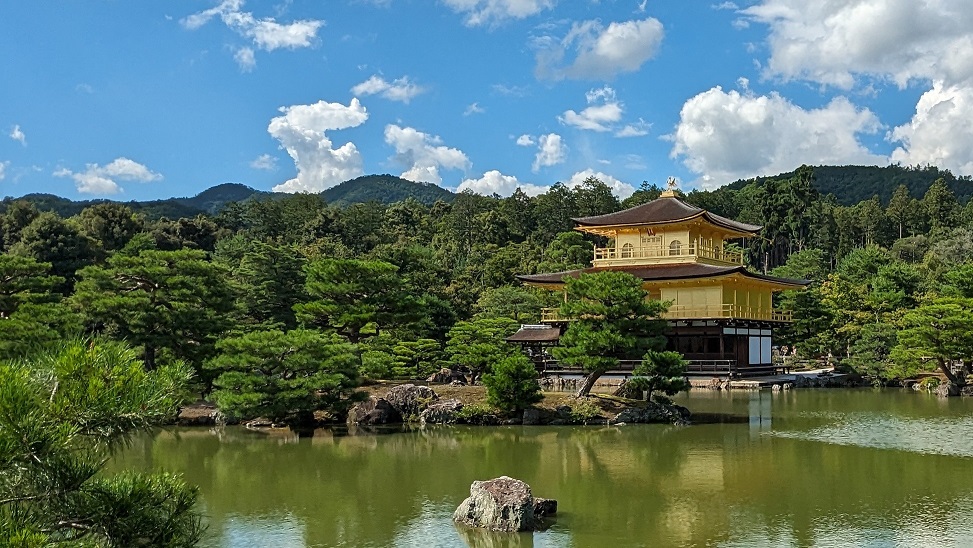
After paying a 500-yen admission fee at the reception, you'll receive a talisman. Upon entering the temple grounds, you'll find yourself in the Rokuon-ji Garden, designated as a Special Historic Site and Place of Scenic Beauty. At its center is the Kyoko-chi Pond, with the golden Shariden Pavilion shining brilliantly.

No matter how many times you see it, the golden Shariden Pavilion is always breathtaking. On the roof is a phoenix. The small island with pine trees in front of the pavilion is called Ashihara Island.

You can walk around Kyoko-chi Pond and admire the Shariden Pavilion from all angles.

The worship route takes you behind the Shariden Pavilion and up a mountain trail. From here, you can see the shingled roof (kokera-buki) and the golden phoenix atop it.
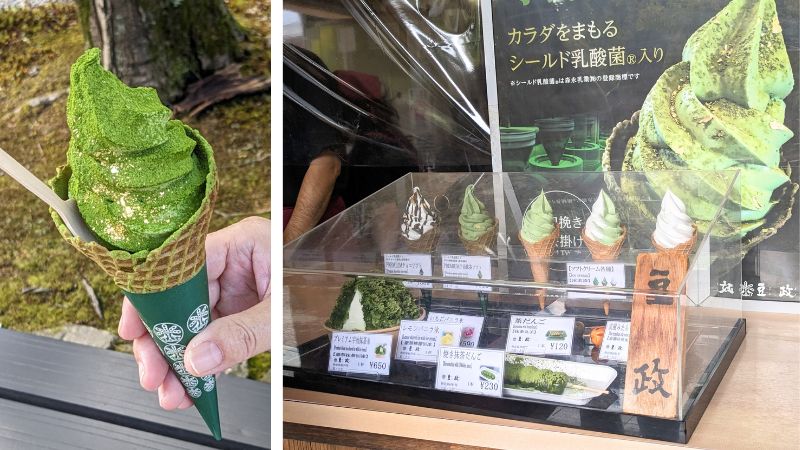
After descending from the rear mountain, you'll arrive at the parking lot and gift shops. Due to the intense heat, I bought a PREMIUM Uji Matcha Ice Cream (with gold leaf) for 650 yen and enjoyed it on a bench. The ice cream, richly topped with matcha, was very thick and flavorful.
The Gozan no Okuribi, also known as the Daimonji Bonfire, is a traditional event held on August 16th in Kyoto. It marks the end of the Obon festival, where the spirits of ancestors are believed to return to the spirit world. The bonfires are lit on five mountains surrounding the city, creating a spectacular sight. Starting at 8pm, the lights will be lit in the following order: "Daimonji", "Myoho","Fune-gata","Hidari-daimonji", and"Torii-gata". Around 19:00, walk east along Imadegawa Dori from Imadegawa Subway Station (toward Kawaramachi Imadegawa). From around 7:15 p.m., we wait for the "Daimonji" to be lit on the bank at the foot of the Kamo Ohashi Bridge, which spans the Kamogawa River. The bonfire is lit at 8pm and remains lit for about 30 minutes.

